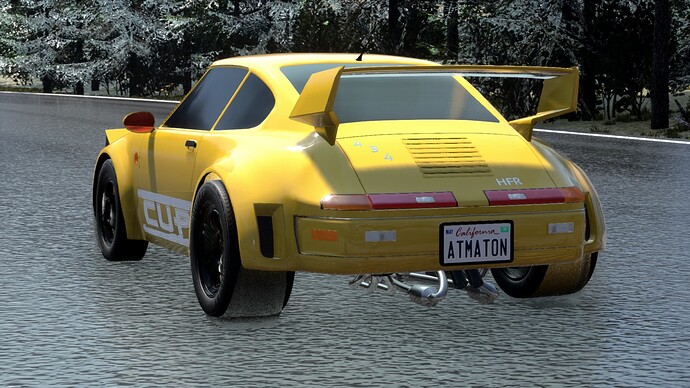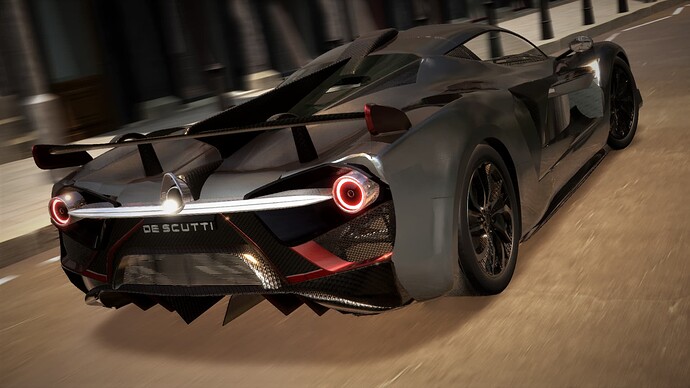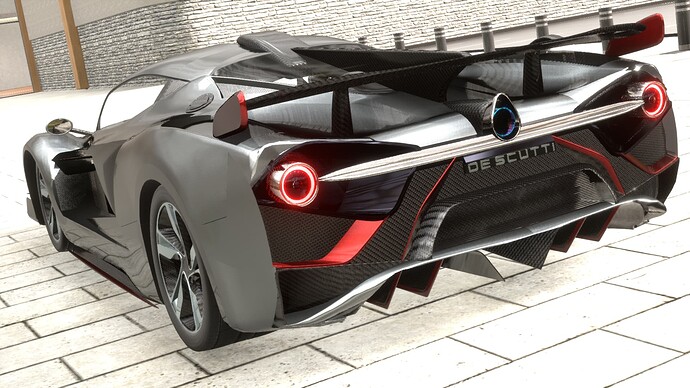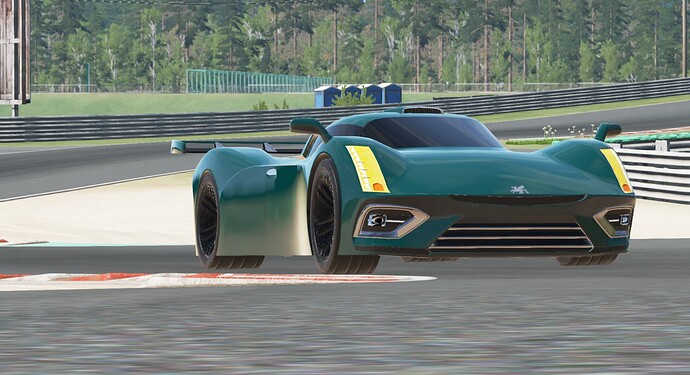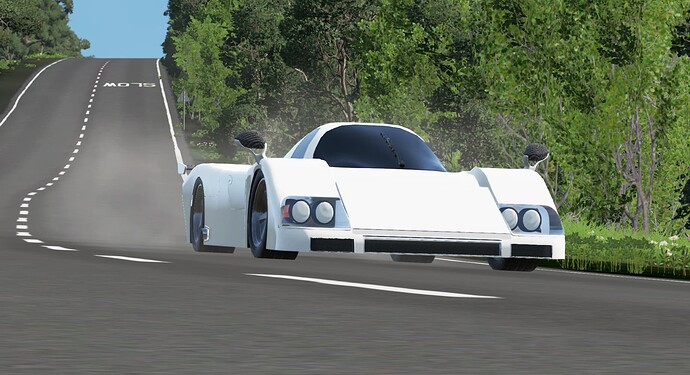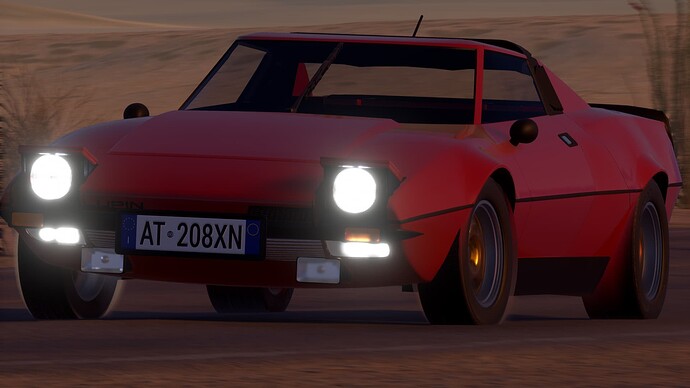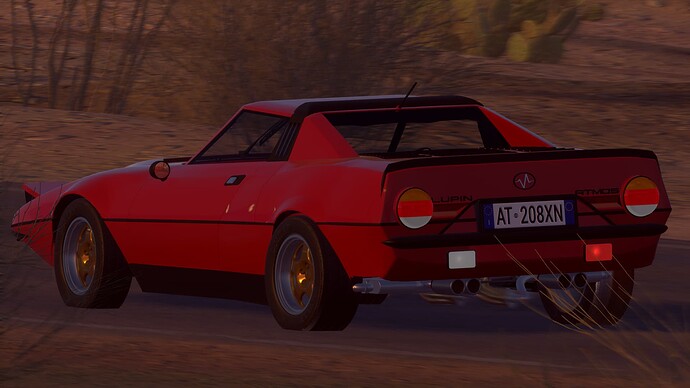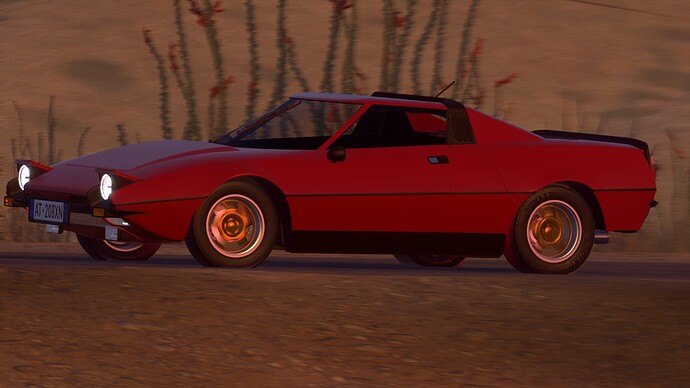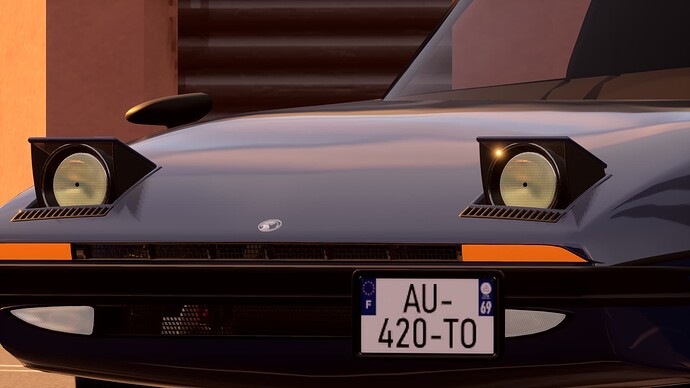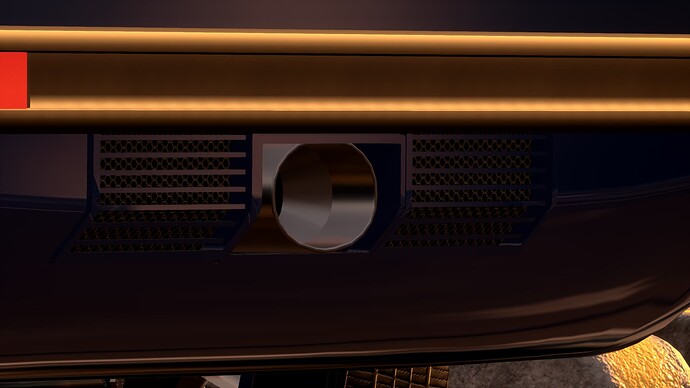Is that a new brand?..and does the first pic have 4 wheel steering? @nate21
I’m sure this was built on one of the new bodies introduced in UE4.27 - it reminds me of a fifth- or sixth- generation Camaro, with an unlock year somewhere between 2005 and 2010 (inclusive) - and is quite a detailed build overall.
And about that odd wheel positioning: It could be due to four-wheel steering, or a combination of a wide offset and high negative camber for the rear wheels.
4WS IS COMING IN 4.2?!?! That’s the end of my bucket list, I can die in peace now.
The look of your car is so good that it can easily appear on your desktop wallpaper.
2019 De Scutti Assoluto
Calcote Sicilia GTR
This was my last car from before the update to 4.2…the 199x C12 series being completed. Goodbye 4.1, you were good to all of us
The 2002 Apex TriStar
The Apex Tristar is clearly one of the best builds I’ve seen based on the 360-esque mod body in FR configuration. What, then, lies under the hood of this beast? At any rate, it wouldn’t look out of place on the cover of a contemporary video game.
I have returned from my hiatus bearing gifts, a two hour Stratos-X1/9 ripoff. enjoy if you want idk
1973 - 1986 Lupin Atmos 2.6
The 1st Generation Lupin Atmos (pronounced “Aht-Moss”) was a small, sleek, lightweight Italian sportscar intended to be fun and exciting whilst still retaining a reasonable price tag and decent fuel economy. Produced by the Lupin Firm from 1973-1999 (1st and 2nd generation) it cost around $28,300 from new, and around $30,200 for the 2nd generation. It was about as barebones as you could get it- the most advanced thing in it was the cassette player provided as an option. It featured a revvy 2.6 litre V6 that produced 156 horsepower, and after 1980 a turbocharged version that made 180. This was mounted transversely right behind the cabin, and was hooked up to a 5 speed manual gearbox with a crude limited slip differential that powered the rear wheels exclusively. This resulted in there being a relatively large frunk and a small trunk, making it actually decently practical, for a sportscar. It had either an 80L or 90L fuel tank, placed underneath the engine and cabin, with a skidplate underneath to protect it.
From 1980 Lupin provided a sort of “facelift” for the car, with a new 12 valve engine as standard, as well as a catalytic converter and turbocharger (optional). It also came with new Pasha cloth seats and optional leather bucket seats. A new steering wheel and gearstick were also introduced, and the fuel tank was moved to the front of the car under the bonnet. The exhausts were also shrunk slightly to boost power minimally and help comply with newer noise regulations (although these could be reverted to the original for free at any dealership) and a third tailight was installed in the rear window, aswell as optional defoggers. As with the first generation, louvers were also optional, but typically reserved for homologation specials.
The Atmos also had a rather long and successful motorsport career, mostly in the form of Group 4 rally, alongside other rally and track variants. It carried multiple wins, including some consecutive ones, and is to this day regarded as a legend of rallying.
The last Gen 1 rolled off of the production line on March 4th, 1986.
1977 - 1983 Melvurne L5 62/110
please note, the rather odd foglamps were not a factory option, due to the fact that they look weird as shit
The Melvurne L5 was a French “sports car” built entirely from scratch by a coke-sniffing Frenchman who saw the Lupin Atmos once and thought ‘why the hell not?’. It was made of plastic and fibreglass and placed on a chassis made of steel tubing. It only had a 1.4 litre I3, producing 62 horsepower that used a FR layout. It came with a 3 speed manual taken from a Citroen and had a top speed of just around 109 miles an hour and a 0-62 time of 12.2 seconds. It cost relatively little at £15,100 and it seemed to be relatively popular among teenagers, due to the fact that it wasn’t very powerful and wasn’t counted as a sportscar by most insurance companies. Many people swapped the asthmatic 3 cylinder for bigger, more powerful engines, mostly V6s and in some cases rotaries.
By 1979 the creator of the car, who can only be presumed to be Mr Melvurne, had amassed quite a bit of money and workers, and set about producing even more models per year. The body was changed to be a new steel molding, and the engine was changed to a 3 litre flat 6 producing 110 horsepower, which quickened the 0-60 time to about 7 seconds and boosted the top speed to 138 miles per hour.
Some people even attempted to race it, with a Group 4 rally and Group 5 race cars being introduced, however neither succeeded in doing anything spectacular.
In 1983 Mr Melvurne died of a heart attack, and the new head of Melvurne decided that the L5 wasn’t a sensible enough car for the company, and had all production ceased immediately. He was fired the following year, and the L5 was brought back into production. The L5 still remains in the Melvurne catalogue today, albeit much more modern than it’s original, 62 horsepower counterpart.
i found this, with 3 fixtures sitting in my WIP bin, and since i was still on a creative high and used to the Stratos body from the Lupin, i decided to make this abomination. i apologise.



